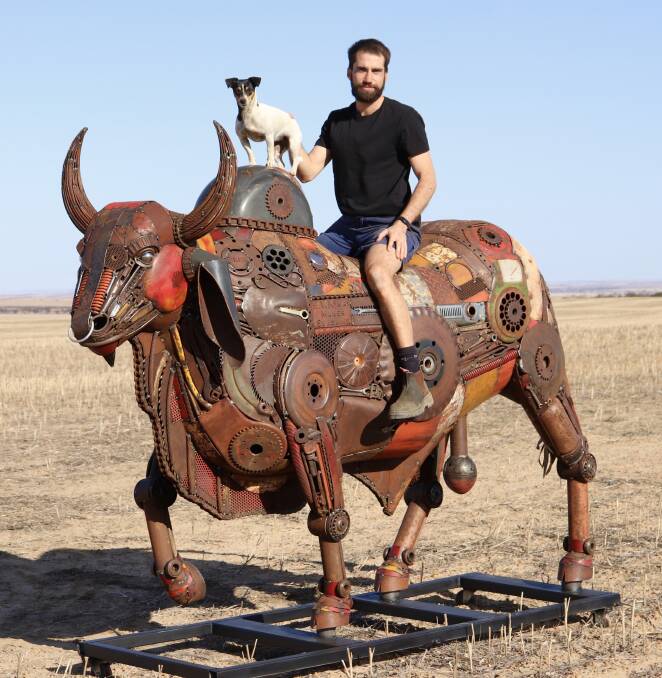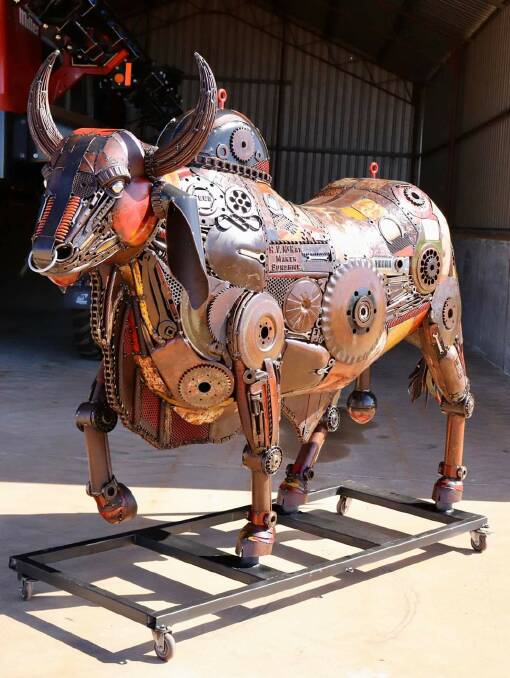
ISOLATION has served artists such as Jordan Sprigg well, providing them with the extra time to focus on their craft.
A farmer's son from Narembeen in the eastern Wheatbelt, Mr Sprigg has been creating sculptures from recycled scrap metals for the past seven years and made a living off his art.
"I don't think I have ever been as productive in my whole life as I have in the past 10 weeks," Mr Sprigg said this week.
"It's been one of those rare moments in our lifetime, where all a lot of people can really do is focus on their work, which isn't necessarily a bad thing - especially if you enjoy it."
Mr Sprigg's most recent creation, the 'Brahman Bull', is a private commission for a New South Wales collector and was in transit to its new owner at the time of writing.
Taking about 350 hours to build and weighing about half a tonne, Mr Sprigg said the bull was made from whatever scrap metal he could find.
"It's all just scrap metal that you find at tips, shovel heads, plough discs, sprockets, chains, bearings and lots of farm gear," Mr Sprigg said.
"The sculpture was made from basically whatever I could find and then welded together so that it resembled the anatomy of a bull."
For each sculpture he commissions, Mr Sprigg encourages his customers to supply a few materials of their own for him to weld into their piece, to create some sentimental value.
"Usually the buyers will provide me with a bit of their old farming gear," Mr Sprigg said.
"I've used old cast iron bits from a Sunshine harvester which they don't make any more - and those parts would have been 80 to 90-years-old.
"It's nice to weld those really old pieces into the sculptures and help preserve that piece of history that bit longer.
"The sculptures also help show the different materials in a new light."

Each year Mr Sprigg creates about 12 sculptures, which usually includes two big pieces that take about three months to make.
With his sculptures on display throughout the State including Narembeen, Quairading and Margaret River, when asked which piece is his favourite Mr Sprigg said it was usually the one he just finished.
"For example, I probably wouldn't have picked to build the Brahman Bull, but once I started the project, I came to realise they are quite an iconic animal in Australia," he said.
"I did a rearing stallion a few years ago which I thought was pretty cool, as I had never done one of an animal rearing up on its two feet, so that one was perhaps a little more unique than the others."
At the time of writing Mr Sprigg was working on a smaller commissioned piece of a marbled gecko.
He said the Australian landscape had definitely influenced his art.
"There's no way I would have picked the medium of recycled metal if I wasn't a farmer's son," he said
"I got started with it because dad said 'this is all you can use' when I first started out, so it's definitely had a huge influence on my art.
"Being out on a farm you have a lot to do with animals, so my sculptures have also been influenced by that aspect as well."
Having completed a three-year degree in psychology, Mr Sprigg said he had put off his fourth year of study, as he was happy to continue on his career path as an artist.
"I'm pretty happy doing what I'm doing, but I think there will be the opportunity for a bit of a side project in the mental health space and incorporating what I'm doing down the track," he said.
"I want to get the message to blokes out there that it's important to talk about your mental health and there's no need to struggle on your own.
"I think by having a hobby you are passionate about, outside of your profession - that can be a really good thing for people's mental health.
"I encourage anyone to pick up a hobby, hopefully while you're young, that you can do it for the rest of your life."
Mr Sprigg said he had been fortunate in being able to make his living as an artist.
"To start with, I didn't actually think that what I was doing was art and I didn't think anyone would pay money for it," he said.
"But my last harvest was in 2013 and I have been working full-time as an artist since then.
"With me, a lot of it has been luck.
"I come from a farm where I can work for free in my dad's shed and I've had a lot of people support me along the way.
"So I would say to kids, do it because of the intrinsic value and enjoyment that comes from creating something and because you want to share your art with the world.
"It's definitely possible to be an artist and you can have an amazing lifestyle, but I also know of a lot of artists who are struggling, especially now.
"Art is a great thing to pursue, but my advice is to only pursue it because you love it."
More information: jordanspriggsculptures.com.au

